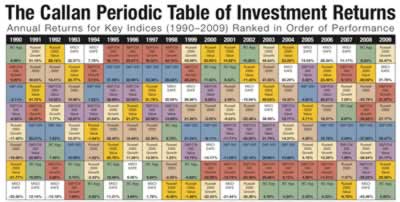Vanguard has the year-to-date returns up to 12/31/2010 for all of their mutual funds available right now, so I made a table with all of the funds and asset classes that I like to track for my records. These are almost all passively-managed funds, so they should track their respective indexes closely. 2010 ended up being a relatively good year for most investors, as nearly all the major stock and bond indexes ended up in positive territory. I’ve listed the mutual fund versions for simplicity, even though there is usually an ETF equivalent with similar returns.
| Fund Ticker | Asset Class | 2010 Total Return |
| Stocks | ||
| VFINX | S&P 500 | 14.91% |
| VTSMX | US Total Market | 17.09% |
| VISVX | US Small Cap Value | 24.82% |
| VGSIX | US Real Estate (REIT) | 28.30% |
| VFWIX | International Total Market | 11.69% |
| VGTSX | International Total Market | 11.12% |
| VFSVX | International Small Cap | 17.09% |
| VEIEX | Emerging Markets | 18.86% |
| Bonds | ||
| VFISX | Short-Term Treasury | 2.64% |
| VIPSX | Inflation-Protected Bonds | 6.17% |
| VBMFX | Total Bond Market Index | 6.42% |
As a reminder that being this year’s best performing asset class is no guarantee of for future years, here’s the Callan Periodic Table of Investments that shows the relative performance of 8 major asset classes over the last 20 years. You can find the most recent one below (click to view PDF), which covers 1990 to 2009. (No update to include 2010 yet.) You can find previous versions here.

As you can see, the top performing asset classes is nearly impossible to predict, so holding multiple, low-correlation asset classes and rebalancing can be beneficial.
 The Best Credit Card Bonus Offers – 2025
The Best Credit Card Bonus Offers – 2025 Big List of Free Stocks from Brokerage Apps
Big List of Free Stocks from Brokerage Apps Best Interest Rates on Cash - 2025
Best Interest Rates on Cash - 2025 Free Credit Scores x 3 + Free Credit Monitoring
Free Credit Scores x 3 + Free Credit Monitoring Best No Fee 0% APR Balance Transfer Offers
Best No Fee 0% APR Balance Transfer Offers Little-Known Cellular Data Plans That Can Save Big Money
Little-Known Cellular Data Plans That Can Save Big Money How To Haggle Your Cable or Direct TV Bill
How To Haggle Your Cable or Direct TV Bill Big List of Free Consumer Data Reports (Credit, Rent, Work)
Big List of Free Consumer Data Reports (Credit, Rent, Work)
Speak Your Mind